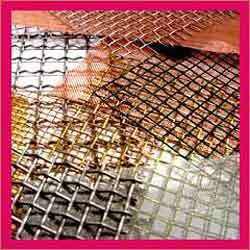Amar Wire Mesh Industries
Product Range
Fact Sheet
- Location:Maharashtra, India
- Year of Establishment:2002
- Business Type:Manufacturer, Retailer, Exporter
- Turnover:Upto Rs. 50 Lakh
(or Upto USD 100 K) - Main Products:Wooven Wire Mesh,Square Wire Mesh,Woven Wire Mesh,Spring Steel
- Reviews & Rating:
Fabricated Wire Mesh
We proudly engage ourselves in manufacturing any kind of fabrication which is related to Fabricated Wire Mesh. With clients increasingly opting for customized fabrication we serve them with a wide range of fabricating articles.
- FOB PriceNA
- Min Order QuantityNA
- Payment TermsNA
Other Details
Fabricated Wire Mesh
Item Code: Customized-Wire-Mesh-Fabrication
We proudly engage ourselves in manufacturing any kind of fabrication which is related to Fabricated Wire Mesh. With clients increasingly opting for customized fabrication we serve them with a wide range of fabricating articles.
Product range:
We provide clients with any type of mesh with wire diameter starting from 2.5 mm.
Material Of Construction :
We make use of any kind of metal for production of these Fabricated Wire Mesh.
Area Of Application :
These are widely used in all type of processing industries such as:
• Mining
• Food
• Paper
• Pulp
• Pharmaceutical
• Fertilizer
• Dairy
• Refinery
End use:
These are best for making following products:
•Baskets
•Strainer
•Filter
•Trays
•Protective guards
•Catalyst support grid as per drawing
This type of mesh is a square grid of uniformly placed wires, welded at all intersections, and meeting the requirements of ASTM A185 and A497 or other standards.[1] The sizes are specified by combining the spacing, in inches or mm, and the wire cross section area in hundredths of square inches or mm2. The common sizes are in the following table
This type of mesh is a square grid of uniformly placed wires, welded at all intersections, and meeting the requirements of ASTM A185 and A497 or other standards.[1] The sizes are specified by combining the spacing, in inches or mm, and the wire cross section area in hundredths of square inches or mm2.
Images





